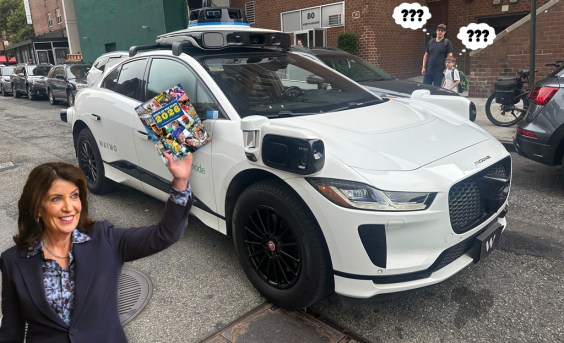
On the evening of Saturday, January 10, 2004, Peter Hornbeck, 26, stepped off the curb at Park Avenue and 96th Street and was struck by a Chevy Suburban traveling 74 miles per hour. The SUV, being driven by a 26-year-old man from Queens who had had his license revoked years earlier, dragged Hornbeck for a block as Hornbeck's friends cried out in horror. The driver, Gurpreet Oberoi, sped off, ditched his SUV and continued by bus to Atlantic City, where he spent the night gambling. Oberoi's friends stayed in the city, went to the police and called Oberoi on his cell phone to urge him to turn himself in. Oberoi was arrested (NYT Select, 2nd item) days later and sentenced (NYT Select) to up to nine years in prison for second degree manslaughter.
In what is something of a success, there has not been a single pedestrian death on Park Avenue between 59th and 96th Streets since that one. But there was a recent near miss in Morningside Heights, where a cab crashed into the three-foot-tall concrete wall on the median at Broadway and 114th Street:
"That wall is the only thing that kept the taxi driver from killing any pedestrians," Detective Bob Winton said. "He was traveling at 40 or 50 miles per hour-anyone crossing the street would have been killed."
Today, the New York Times has a report about Streetsblog's own Glenn McAnanama, an Upper East Side resident, who is asking his community board to approve similar concrete walls or metal bollards for the Park Avenue malls:
A spokesman for the Parks Department, which has jurisdiction over the malls, said the department had little information about the idea. A Transportation Department spokeswoman, Kay Sarlin, said that the malls themselves "provide a safe refuge" and that the agency considered bollards unnecessary.
Margaret Ternes, the executive director of the Fund for Park Avenue, said that she is not necessarily opposed to the idea but is baffled by the emergence of the issue, since she could remember few accidents involving pedestrians crossing Park Avenue. According to the Department of Transportation, one pedestrian died on Park Avenue between 59th and 96th Streets in 2003, one in 2004, and none since.
The bollard issue emerged right here on Streetsblog, where Aaron Naparstek showed in October 2005 that bollards protect pay phones and fire hydrants throughout the city, but rarely are used where people are likely to stand. It isn't just Park Avenue where opportunities to improve pedestrian safety exist. Here's a photo of Park Row next to City Hall.

Notice the bollards protecting the hydrant from errant motorists while people waiting on the refuge island are vulnerable. It is great to see Glenn taking the lead and setting the agenda on pedestrian safety, even if others find this baffling.
(Photo credits: Top: Daniella Zalcman/Columbia Spectator and Flickr; Bottom: Aaron Donovan/Streetsblog)





